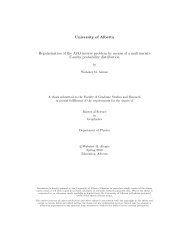Soner Bekleric Title of Thesis: Nonlinear Prediction via Volterra Ser
Soner Bekleric Title of Thesis: Nonlinear Prediction via Volterra Ser
Soner Bekleric Title of Thesis: Nonlinear Prediction via Volterra Ser
You also want an ePaper? Increase the reach of your titles
YUMPU automatically turns print PDFs into web optimized ePapers that Google loves.
3.3. 1-D SYNTHETIC AND REAL DATA EXAMPLES 41<br />
clear that quadratic and cubic terms are needed to capture the strong variability<br />
observed in the time series.<br />
In Figure 3.5(c) I portray the contribution due to the linear terms <strong>of</strong> a third-<br />
order <strong>Volterra</strong> series to predicted the data in Figure 3.5(b) due to the linear terms <strong>of</strong><br />
third order <strong>Volterra</strong> series. Note that this contribution is negligible and shows that<br />
linear terms can not model the highly nonstationary part <strong>of</strong> signal. Figures 3.5(d)<br />
and 3.5(e) illustrate the parts <strong>of</strong> the prediction associated with quadratic (q = 8)<br />
and cubic (r = 8) terms in the third-order <strong>Volterra</strong> series. Figure 3.5(f) shows the<br />
contribution <strong>of</strong> nonlinear terms associated with quadratic and cubic terms (q = 8<br />
and r = 8). It is clear that nonlinear quadratic and cubic terms are required to<br />
properly model the full aperture.<br />
A real data example corresponding to the so called Arctic oscillation time series<br />
(AO)-a time series from 1950 to 1999 <strong>of</strong> sea level pressures-is used to characterize<br />
the long term variability <strong>of</strong> nonseasonal sea level oscillations (Thomson, 2004).<br />
Figures 3.6(a) and 3.7(a) show the nonlinear AO data for the period from 1950<br />
to 1999. The data consist <strong>of</strong> 104 samples (3 observations per year-January, February<br />
- March). Figures 3.6(b) and 3.6(c) illustrate predicted AO values for a <strong>Volterra</strong><br />
system consisting <strong>of</strong> linear and nonlinear terms (p = 10, q = 10, and r = 10) and<br />
associated error, respectively. Figures 3.6(d) and 3.6(e) represent our attempt to<br />
model the data with a linear prediction filter (p = 10) and corresponding error.<br />
Again, it is clear that the dynamics <strong>of</strong> the time series is better captured by the<br />
third-order <strong>Volterra</strong> system.<br />
Figure 3.7(b) is the prediction using a third-order <strong>Volterra</strong> series with p = 10,<br />
q = 10, and r = 10. In Figure 3.7(c) I portray the part <strong>of</strong> the prediction attributed









